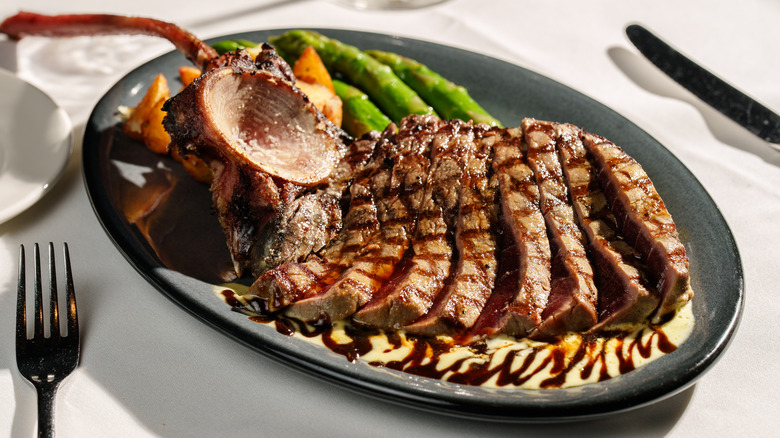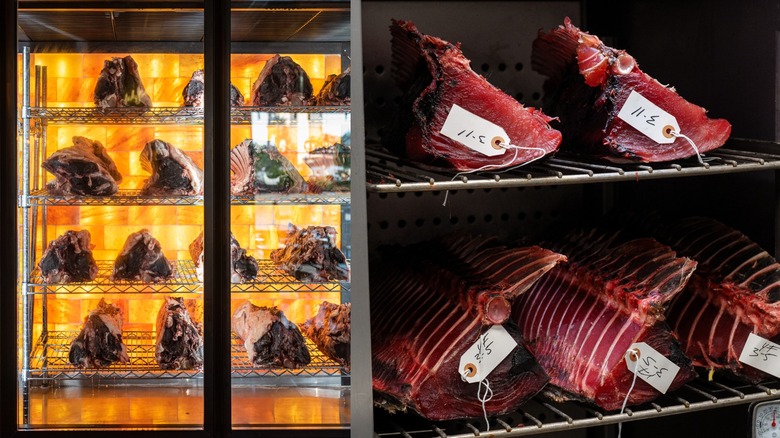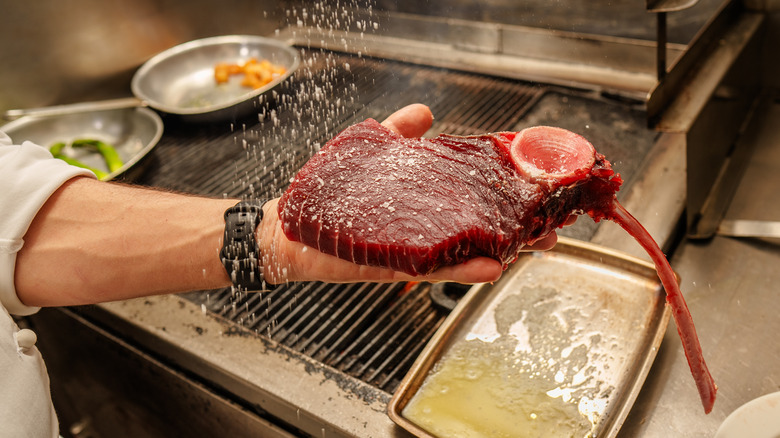Why You Should Consider Dry Aged Fish As A Steak Alternative
Dry aging has been the hottest trend in the carnivore world for years. It's how steakhouses transform ordinary beef into the best steaks you've ever eaten. The process involves aging meat in a climate-controlled chamber in order to enhance its taste and texture. During the aging process, water naturally present in the meat evaporates, making the flavor much more concentrated. At the same time, enzymes in the meat begin to break down tough muscles and connective tissues. The result is extra-tender and extra-flavorful meat.
The dry aging technique has been around since the Renaissance era, but it has gained even more attention lately with the rise of social media. Searches for "dry aged" on YouTube and TikTok yield videos with millions of views. Nearly all of them focus on the same kind of meat: beef, but while steaks have dominated the dry aging trend, they're far from the only thing you can dry age. Lately, a growing number of restaurants have been pushing a different option: dry aged fish. It might sound impossible that the fanciest fish restaurants serve isn't fresh, but that's just what many chefs are now claiming.
Dry aging fish works via the same basic principles as dry aging beef steaks, but the process is a bit more complicated. Fish is more prone to swift spoilage than beef, and it takes a true professional to properly dry age one. In the end though, you get a piece of fish that tastes remarkably similar to a piece of red meat.
The differences between dry aging fish and dry aging steak
No matter what kind of protein you're using, dry aging follows the same basic process. The meat is stored in a chamber where both temperature and humidity are tightly regulated. These conditions are similar for aging beef and fish. Specifically, the chamber needs to be kept just barely above freezing, with the relative humidity set between roughly 70% and 85%. This might sound high, but it's actually quite dry. Relative humidity is called such because it is calculated in relation to temperature, and it is always higher in cold temperatures. All told, there isn't really a difference in the conditions used to dry age fish versus beef, but there are differences in the time and prep work.
The biggest difference between dry aging beef versus fish is that fish take a much shorter time. Steakhouses usually age beef for about a month, some going as long as 90 days. Most fish, on the other hand, are only aged a few days, as any longer would cause the flesh to break down too much and become overly flaky. Large fish, like whole tuna and swordfish, can be aged for a couple of weeks up to a month. Another key difference is that, unlike beef, fish is aged with the skin on. This causes the skin to become extremely dry, which in turn helps it to get ultra crispy when cooked. Additionally, beef is often salted before aging, while fish can be but sometimes is not.
How dry aged fish tastes compared to dry aged beef
You would never think that fish could satisfy your craving for steak, but dry aging makes fish taste remarkably similar to red meat. That's because the dry aging process removes the strong fishy flavor that turns some people away from seafood. That flavor comes from moisture in the fish, which can include traces of blood. Dry aging causes this moisture to evaporate, removing the fishy flavor. Furthermore, fresh fish is often tainted with the smell of ammonia, which develops when the fish are washed at the fishmonger's. It's why fish markets aren't exactly known as a treat for the nostrils. However, keeping the fish in a dry climate prevents ammonia from developing.
When oceanic odors are removed, the umami flavors in fish come to the forefront, just as in the flavor profile of beef. For something with a similar richness to steak, you need a fatty fish like bluefin tuna. Dry aging will make the fish denser and firmer, but it won't be tough to chew because the fat keeps everything moist. Dry aging beef has the same effect, but the denser texture is actually why dry aged steaks are tricky to grill. With fish, you have a wider variety, making it more versatile and suited to different preparations. Try it raw and thinly sliced for a sashimi experience like no other.


